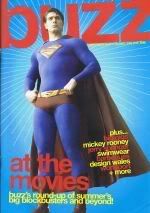Revenge of the Sith (2005)
You could cut the tension in the cinema with the old proverbial as the lights dim. Collectively, the audience is holding its breath as that oh-so-familiar title sequence rolls: this is it. Revenge of the Sith is the final episode, George Lucas’s final chance to redeem a faltering franchise. Entire generations have been brought up on Star Wars; it’s been a part of their lives for as long as they can remember. The original “Holy Trilogy” has passed into common consciousness, while the cruelly disappointing Episodes I and II are all but synonymous with "cinematic turkey". Perhaps never before has a film had so much to live up to, and here's the news everyone wants to hear, yet can't quite bring themselves to believe: Star Wars Episode III: Revenge of the Sith is worth the wait.
Lucas has been quoted as saying that Revenge of the Sith is "like Titanic in space." Sadly, there's nothing even remotely resembling an "I'm flying!" scene; but in a round-about, Uwe Boll kind of way, Lucas is correct: we already know what's going to happen, and we’re all just waiting to get to that iceberg, knowing there’s going to be one hell of a crash when we get there. "Spoilers" for Revenge of the Sith therefore seem rather redundant, but it's all those little things that matter. Watching Jar Jar Binks set up "Chancellor" Palpatine and thus help lay the foundations of the Empire, watching Anakin and Padme fall in love, and watching Anakin's arrogance and rage grow as his Jedi training progresses – this is what it's all about. Revenge of the Sith, more than the other prequels, is the real, ultimate pay-off for years of being a science-fiction nerd.
Connecting the original trilogy to the prequels is a tall order, especially because most of the original actors can't return, for obvious reasons. There are a lot of loose ends to tie up: somehow, the Jedi order must be destroyed, the galaxy thrown into disarray, and an entirely new world order must be established if Revenge of the Sith is to lead seamlessly into A New Hope. The geeky joy in the room is almost overwhelming when some familiar characters – Luke’s adoptive parents, Senator Organa, and, most excitingly, Chewbacca – make their appearances, though the non-appearance of some others inspires similar joyfulness. Jar Jar Binks, scourge of the known universe, only gets two very, very brief scenes, with only two words of dialogue. This is perhaps indicative of the target audience for this movie: while The Phantom Menace was allegedly aimed at 8-12 year olds, and Attack of the Clones at moody teenagers, Revenge of the Sith is a decidedly grown-up movie. It’s far darker than its predecessors, with even more horrendously charred corpses than A New Hope. The violence is almost non-stop – it wouldn’t be Star Wars without lightsaber battles, and they’re here in abundance. Every single one is breathtaking, awesome in its own particular way: General Grievous vs. Obi Wan Kenobi is awesome because they have an incomprehensible total of five lightsabers between the two of them; Mace Windu vs. Palpatine is awesome because it includes both a purple lightsaber and, speciality of the Dark Side, blue finger-lightning (and perma-cool Samuel L. Jackson, though that goes without saying); and Dooku vs. Anakin is awesome because it marks a particular stage in Anakin’s transformation from Jedi to Sith Lord – and one of the coolest lightsaber deaths ever.
Hints at Anakin’s fate have been scattered throughout the prequels, and it’s perversely satisfying to see it all finally come together. The longed-for “Rise, Lord Vader” line and the first strains of the Imperial March raise goosebumps that don’t subside in a hurry; there’s an unshakeable sense that this is history in the making. One by one, all the absolutes we’ve come to rely upon are destabilised – the previously untouchable Jedi are revealed as fallible, their philosophy flawed and unsatisfactory. The familiar “search your feelings” refrain rings hollow as it becomes increasingly clear that feelings are not to be relied upon, or even, in most cases, indulged. Fear leads to the Dark Side – as does anger, and love, or passion of any kind. Democracy quickly disintegrates into totalitarianism, and no-one can be relied upon. Anakin’s fatal flaw, it seems, is feeling too much: in a decidedly paradoxical turn of events, he submits himself to the Emperor’s will only in order to learn the secret methods of keeping death at bay – to save, not himself, but his beloved wife. Yet after allowing the Dark Side to consume him, Anakin is rejected by Padme, and here, again, the movie takes a dark turn as he responds with the trademark Darth Vader death-grip. It’s a tense moment, almost a Mexican standoff between Obi-Wan and Anakin, with the heavily pregnant Padme trapped in the middle. This bizarre sci-fi brand of domestic abuse isn’t even close to being the most disturbing scene in the movie: in order to complete his transformation into a Sith Lord – a move provoked, largely, by reluctance on the part of the Jedi Council to grant him the rank of Master – Anakin massacres all the “younglings” in the Temple. It’s not the first time Anakin’s gone on a killing spree that didn’t limit itself to armed, capable opponents, but there’s something remarkably chilling about how calculated this particular attack is. Bizarrely, the worst scenes, and, difficult though it is to say this, worst acting in this movie comes from the unexpected quarter of Natalie Portman. Hayden Christensen’s strangely flat performance is actually appropriate to the character, but the usually far superior Portman just isn’t convincing. Perhaps it’s because there’s no chemistry between them whatsoever, or perhaps it’s due to the trademark abysmal dialogue, but something just isn’t right. Usually, when Natalie cries, I cry; this time, I just felt some vague disgust and waited for the scenes to be over. Considering we’ve seen Padme in kickass action in the previous two movies, I’m willing to cut her some slack here, especially since she’s pregnant and therefore undoubtedly an emotional mess, but it seemed rather as though Lucas was desperately trying to find a role for Padme where she really didn’t fit. A better decision might have been to have her go into hiding to disguise her pregnancy, thereby conveniently disposing of a superfluous character till the birth scene, when she became necessary again.
Although, actually, the birth scene was probably the most awkward part of the movie: firstly, with all the technology floating around, how come no-one thought to give her a scan? Secondly, her naming of the babies is cringeworthy, not least because it’s totally unnecessary. Hands up who didn’t know the twins were Luke and Leia? I rest my case. Finally, Padme’s death is incredibly undignified, and completely unbefitting of a character of her calibre. Like midichlorians and Jar Jar Binks, the whole “medically, there’s nothing wrong with her, she’s just lost the will to live” exchange has been consigned to the circular file of my memory. There were unforeseen complications in childbirth, mostly due to the fact that no-one knew she was expecting twins. Uh-huh, that’ll be what happened.
Padme’s death is the only part of Revenge of the Sith that even slightly detracts from the overall awesome, though, so it’s easily forgiven. There’s so much to ease the pain: so many nods to the fandom, so many issues ironed out: in one line (“Have the protocol droid’s memory wiped”) continuity problems are swept away; appeasements are offered for old grievances, as Kashyyyk replaces Endor as the planet of the Wookiees. The CGI, though perhaps somewhat overused, is beautiful as ever: entire planets come to life, brimming with the sort of weird creatures we’re used to Star Wars providing but which, nevertheless, are mind-blowing the first time they appear. The space battles are where Star Wars has always excelled itself, and Revenge of the Sith is no different. It’s exhilarating to watch the technology develop towards the x-wings we’re familiar with, whilst the proto-Death Star is orgasmic. Star Wars has always been a visually rich franchise: and in this pivotal episode, appearances are everything. Anakin’s turn to the Dark Side is marked by his adoption of the black, hooded cloak of the Sith Lords and the only slightly more subtle insertion of blazing red contact lenses into his eyes. Although I’ll only grudgingly concede that maybe Hayden Christensen isn’t the worst actor on the planet, ever, he is undeniably beautiful, a factor that helps emphasise all the more strongly how far he really has fallen. The emotionally fraught volcano-side lightsaber battle between Anakin (or, um, Vader, actually, but I’ll cling to the past just a little longer) and Obi-Wan deserves acclaim for managing to maintain some dramatic tension in spite of its inevitable outcome; but the culmination of this scene is far from pretty. Having sliced off both of Anakin’s legs, Obi-Wan can only watch, distraught, as his one robot hand desperately clings to the ground, unable to prevent the flames consuming his body, charring him beyond all recognition. This is the point of no return; this is the all-important moment in the formation of the man we now know as Darth Vader, and it’s unspeakably powerful. You’d need to be a much stronger, hard-hearted Star Wars fan than me to sit through this unmoved, and it’s moments like these that eclipse the less than perfect scenes – or even the entire mess of the previous two prequels. Against all odds, Lucas’s real vision sometimes shines through: and it’s almost blindingly beautiful. Moments like this both rip open old wounds and kiss them better: if only The Phantom Menace could have been so well crafted.
Revenge of the Sith really is the movie we’ve all been waiting for. It’s a Star Wars movie for Star Wars geeks; it’s the episode where evil triumphs, where the Empire is established and the villains emerge, fully formed, ready to take over the galaxy. It’s not a family friendly movie, either: this is Star Wars for grown-ups, the way it always should have been.
IMDB link










No comments:
Post a Comment